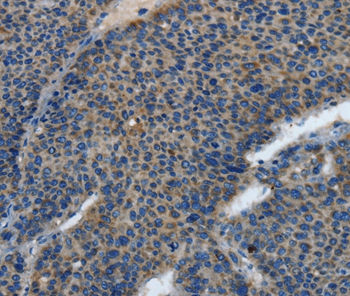Product Detail
Product NameTLR4 Antibody
Host SpeciesRabbit
ClonalityPolyclonal
PurificationAntigen affinity purification.
ApplicationsWB IHC
Species ReactivityHu
SpecificityThe antibody detects endogenous levels of total TLR4 protein.
Immunogen TypeRecombinant Protein
Immunogen DescFusion protein corresponding to a region derived from internal residues of human toll-like receptor 4
Target NameTLR4
ConjugateUnconjugated
Other NamesTOLL; CD284; TLR-4; ARMD10
Accession NoSwiss-Prot#: O00206
NCBI Gene ID: 7099
Gene Accssion: BC117422
Uniprot
O00206
Gene ID
7099;
Sdspage MW96kd
Concentration1.1mg/ml
FormulationRabbit IgG in pH7.4 PBS, 0.05% NaN3, 40% Glycerol.
StorageStore at -20˚C
Application Details
Western blotting: 1:500-1:2000
Immunohistochemistry: 1:25-1:100
Gel: 6%SDS-PAGE
Lysate: 60ug K562 cell
Primary antibody: 1/550 dilution
Secondary antibody dilution: 1/8000
Exposure time: 1 minute
Immunohistochemical analysis of paraffin-embedded Human liver cancer tissue using #35577 at dilution 1/25.
The protein encoded by this gene is a member of the Toll-like receptor (TLR) family which plays a fundamental role in pathogen recognition and activation of innate immunity. TLRs are highly conserved from Drosophila to humans and share structural and functional similarities. They recognize pathogen-associated molecular patterns that are expressed on infectious agents, and mediate the production of cytokines necessary for the development of effective immunity. The various TLRs exhibit different patterns of expression. This receptor has been implicated in signal transduction events induced by lipopolysaccharide (LPS) found in most gram-negative bacteria. Mutations in this gene have been associated with differences in LPS responsiveness. Multiple transcript variants encoding different isoforms have been found for this gene.
If you have published an article using product 35577, please notify us so that we can cite your literature.
et al,Anti-inflammatory Mechanism of Bone Marrow Mesenchymal Stem Cell Transplantation in Rat Model of Spinal Cord Injury.In Cell Biochem Biophys.On 2015 Apr by Han D, Wu C et al..PMID:25388837
, (2015),
PMID:
25388837
et al,Phthalide derivative CD21 attenuates tissue plasminogen activator-induced hemorrhagic transformation in ischemic stroke by enhancing macrophage scavenger receptor 1-mediated DAMP (peroxiredoxin 1) clearance
, (2021),
PMID:
34162400




 Yes
Yes



